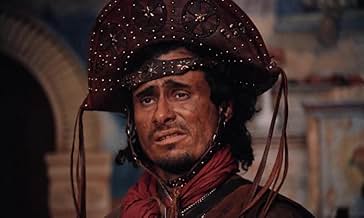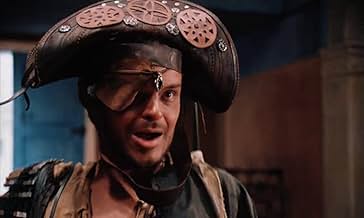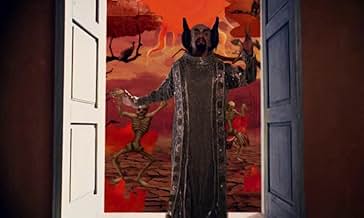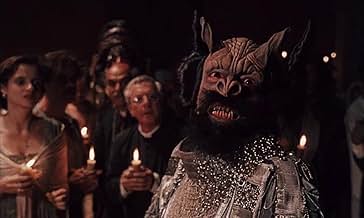O Auto da Compadecida
- 2000
- 1h 44min
VALUTAZIONE IMDb
8,6/10
20.478
LA TUA VALUTAZIONE
Aggiungi una trama nella tua linguaThe lively João Grilo and the sly Chicó are poor guys living in the hinterland who cheat a bunch of people to survive, but their plans are halted when a bandit comes to town.The lively João Grilo and the sly Chicó are poor guys living in the hinterland who cheat a bunch of people to survive, but their plans are halted when a bandit comes to town.The lively João Grilo and the sly Chicó are poor guys living in the hinterland who cheat a bunch of people to survive, but their plans are halted when a bandit comes to town.
- Regia
- Sceneggiatura
- Star
- Premi
- 10 vittorie e 10 candidature totali
Recensioni in evidenza
O Auto de Compadecida is a funny film, in more ways than one. At first, I was baffled by the storyline, or rather, by the lack of a storyline such as I'm used to. If you expect the first five or ten minutes of a film being devoted to introducing the characters, their backgrounds, and their passions, you'll find yourself puzzled by this flick. There is hardly any introduction or explanation, and such as is offered appears exactly at the appropriate moments. The film is also funny in content. The main characters are a teller of unlikely stories and a schemer of impossible schemes, who never reach the third dimension, but then, there's no need for that: the burlesque quality and speed of the scenes thrive on these two men being cartoon characters rather than real people. And truly, an in-depth character would be highly out of place in a scene which involves Jesus, Mary, and Lucifer doodling in the margins of a book--using blood as ink, naturally. Highly enjoyable.
It is amazing how, from the very beginning of this movie, you notice the influence that Terry Gilliam has had on this Brazilian director. The movie has the twists and craziness you would expect of "Adventures of Baron Munchausen", but from the third world, portraying incredible well the way people try to survive where there is not much for them anyway. "O Auto da Compadecida" is definitely a very good movie, with talented actors and unexpected plot. Must-see.
When the 4-chapter mini-series was announced by Globo network, few people expected it to be THAT good, for the simple reason that nothing that good had been done in Brazilian television in the previous 15 years. The adaptation is efficient, departing very little from Cabral de Mello Neto's text and mood, the direction, scenography and art direction are beautiful, the humour is well balanced with adventure and drama, everything works well. But the real treat you get watching this is Nachtergale's performance as Joao Grilo. This is the production that made everyone agree that he is the best actor of his generation by a mile. Let me talk a little of what the story is about. It is not really a 'fantasy' of the writer as some American viewers (understandably) thought. The play's proposal is to be an adaptation of several texts from the tradition of 'cordel literature', typical of the Brazilian northeast (where the play is set). Those texts are mostly long poems that translate the folklore of that region. It is, of course, a very catholic area, but in a very peculiar way. Jesus ('Manuel'), Mary ('the Merciful') and the devil ARE common characters of those folk stories, and they are as 'accessibile' to people as the movie shows in Brazilian Folklore. Also from 'Cordel literature' comes the character of 'Joao Grilo'. Anyone who sees this movie and don't know Grilo should watch for Shakespeare's 'Henry IV' (the character Falstaff) and Moliere's 'Scapino'. It is sort of a universal character the court's fool, and doesn't belong to Arraes, Mello Neto or even to Brazilian Folklore. So it is not really someone's fantasy it is the fantasy of an anonymous collective, the people from Brazil's northeastern 'sertao'. It is a great movie anyway, I just thought people would like to know the background.
Before watching it, get this straight !
1- This movie is an adaptation from a original play and smaller works from the same author (1955).
2- This is not how Brazil is today in the country side but how it was at the beginning of the 20 century (circa 1920). Sort of Brazilian Wild West (in our case Wild East).
3- This was a TV series much longer and was reduced to almost 1/3 of its original size for the theaters and DVD due to the great viewers ratings of the TV series.
4- Much of the jokes and characters are local to the region shown in the movie: Sertão Brasileiro.
5- To understanding the movie you should really know Brazilian Portuguese, some local accents related to the plot and the colloquial words used make it very tricky to translate, and in many cases, impossible. I watched also with English subtitles, and believe me: most of the jokes are gone.
6- There is no parallels between this movie and "Cidade de Deus" (City of God). You can argue about the technical aspects of them but for me, is like comparing "much ado about nothing" (from Shakespeare) and American Pie. To really appreciate "much ado..." you you must master the English Victorian world completely (of course... its out of my league. Eng. is not my first !). Or like old Italian comedies from the 60 and 70 where many joke relay on gestures that a foreign just cant understand.
7- And about the religious ending, its a joke inside the joke. And of course, if you cut a work that takes 3 1/2 hours to just 90 minutes and thinks that its the same thing.
...for example, for a native Brazilian, its just hilarious to see a black Jesus, a Zelot Devil and organized one following rules by the book.
In the other hand, you could compare this movie to DOGMA (Kevin Smith). And its way better than DOGMA.
Thats all folks...
And of course... I'm a Brazilian.
1- This movie is an adaptation from a original play and smaller works from the same author (1955).
2- This is not how Brazil is today in the country side but how it was at the beginning of the 20 century (circa 1920). Sort of Brazilian Wild West (in our case Wild East).
3- This was a TV series much longer and was reduced to almost 1/3 of its original size for the theaters and DVD due to the great viewers ratings of the TV series.
4- Much of the jokes and characters are local to the region shown in the movie: Sertão Brasileiro.
5- To understanding the movie you should really know Brazilian Portuguese, some local accents related to the plot and the colloquial words used make it very tricky to translate, and in many cases, impossible. I watched also with English subtitles, and believe me: most of the jokes are gone.
6- There is no parallels between this movie and "Cidade de Deus" (City of God). You can argue about the technical aspects of them but for me, is like comparing "much ado about nothing" (from Shakespeare) and American Pie. To really appreciate "much ado..." you you must master the English Victorian world completely (of course... its out of my league. Eng. is not my first !). Or like old Italian comedies from the 60 and 70 where many joke relay on gestures that a foreign just cant understand.
7- And about the religious ending, its a joke inside the joke. And of course, if you cut a work that takes 3 1/2 hours to just 90 minutes and thinks that its the same thing.
...for example, for a native Brazilian, its just hilarious to see a black Jesus, a Zelot Devil and organized one following rules by the book.
In the other hand, you could compare this movie to DOGMA (Kevin Smith). And its way better than DOGMA.
Thats all folks...
And of course... I'm a Brazilian.
"O Auto da Compadecida," commonly translated as "A Dog's Will" (a translation which, to my ears, waters down the significance, the gravitas, and the poetry of the title in the original) is a sure-classic and a phenomenon of the Brazilian cinema and popular culture of the recent past and of modernity in the rural communities of its countryside. The film has marked the heart and the soul of an entire generation since the dawn of the twenty-first century, and features lines and words still common-parlance among the average Brazilian (e.g., João Grilo's : "Não sei não... Só sei que foi assim. ("I don't know--all I know it was so"))
All in all, the film portrays themes of class, spiritual feelings, and some legendary figures of the folklore and of the past of the Brazilian drylands and Northeast. In a way, "O Auto da Compadecida" memorializes through the friendship of Chicó and João Grilo an entire generation and past, an entire dialectic and language, all done with outstanding actors, actresses, and acting overall.
This is surely a landmark of Brazilian cinema, imagination, and one that is sure to delight those open to receive its humor and themes of love, spirituality, redemption, and forgiveness.
All in all, the film portrays themes of class, spiritual feelings, and some legendary figures of the folklore and of the past of the Brazilian drylands and Northeast. In a way, "O Auto da Compadecida" memorializes through the friendship of Chicó and João Grilo an entire generation and past, an entire dialectic and language, all done with outstanding actors, actresses, and acting overall.
This is surely a landmark of Brazilian cinema, imagination, and one that is sure to delight those open to receive its humor and themes of love, spirituality, redemption, and forgiveness.
Lo sapevi?
- QuizThis is the third adaptation of Ariano Suassuna's "O Auto da Compadecida".
- ConnessioniEdited from O Auto da Compadecida (1999)
- Colonne sonoreCaboclos de Orubá
Written by Sá Grama
Performed by Sérgio Campelo, Gilberto Campello, Jônatas Zacarias, Antônio Barreto,
Frederica Burgeois, Cláudio Moura, Fábio Delicato, Neide Alves and Thiago Fournier
Arranged and Produced by Sá Grama
I più visti
Accedi per valutare e creare un elenco di titoli salvati per ottenere consigli personalizzati
- How long is A Dog's Will?Powered by Alexa
Dettagli
Botteghino
- Lordo in tutto il mondo
- 6.281.890 USD
- Tempo di esecuzione1 ora 44 minuti
- Colore
- Mix di suoni
- Proporzioni
- 1.66 : 1
Contribuisci a questa pagina
Suggerisci una modifica o aggiungi i contenuti mancanti

Divario superiore
What is the Spanish language plot outline for O Auto da Compadecida (2000)?
Rispondi





























